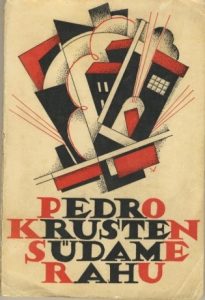Since 2009 my colleagues and I have taken special pains to bolster Columbia’s holdings of rare (and in some cases unique) titles in Baltic & East European modernist materials from the dynamic interwar decades, as well as avant-garde (Surrealist, Expressionist, Dadaist, etc.) literature. We have secured a number of notable acquisitions—more than 150, by my
 reckoning, held by either Avery Classics or RBML―that have cemented our position as the premier “destination” collection of such materials in North America. Scholars are now examining the original and inflected contributions of indigenous intellectuals and artists in the context of broader European literary, artistic, architectural and political movements. The addition of Polish, Latvian, Estonian, Croatian, Serbian, Hungarian, and Romanian interwar imprints over the past half-decade has established Columbia as an important repository for such materials.
reckoning, held by either Avery Classics or RBML―that have cemented our position as the premier “destination” collection of such materials in North America. Scholars are now examining the original and inflected contributions of indigenous intellectuals and artists in the context of broader European literary, artistic, architectural and political movements. The addition of Polish, Latvian, Estonian, Croatian, Serbian, Hungarian, and Romanian interwar imprints over the past half-decade has established Columbia as an important repository for such materials.
This past fall, thanks to support from Columbia’s Primary Resources Fund, we were able to acquire a group of four exceptionally rare Estonian Modernist publications and two serials from the interwar period:
- Pedro Krusten, author of Südame rahu. Romaan [Peace of Mind. A Novel] (Tartu, 1928) would achieve fame in his postwar fiction in exile, winning the Visnapuu Award for Literature in 1958. The cover design is by Jaan Vahtra;
- Julius Öngo’s Ööpäev [Day and night] (Haapsalu (Tallinn), 1921) was issued in an edition of less than 150 copies, with a woodcut cover and five full-page woodcuts by artist Aleksander Bergmann (pseud. of Aleksander Vardi 1901-1983).
- Hugo Raudsepp was a prolific playwright, journalist and critic who perished in a Siberian labor camp. His Pörunud aru õnnistus [Understand the blessing] Tartu, 1931), has a cover design by Peet Aren.
- Rudolf Reimann’s Päikseratas. Poeem [Wheel of the sun. Poems] (Võrun, 1922) contains woodcuts by Vahtra.
- Dünamis. Mõtteid võitlevast vabariigist. [Cultural notes. Thoughts about the struggle for the Republic] (Tartu, 1928) was the first and last issue of a journal launched to celebrate the 10th anniversary of the Estonian Republic. It provoked such a strong reaction that it was shut down by the authorities and confiscated with only a few hundred copies actually released. Cover design by Vahtra.
- Kirjanduslik kuukiri. [Beauty. A literary monthly] (Tartu, 1919-1921) 11 of 12 numbers each containing full-page illustrations and many original graphics showcasing a single artist, and literary contributions by Estonia’s leading modernists.

